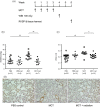Low dose 100 cGy irradiation as a potential therapy for pulmonary hypertension
- PMID: 31012111
- PMCID: PMC6660348
- DOI: 10.1002/jcp.28723
Low dose 100 cGy irradiation as a potential therapy for pulmonary hypertension
Abstract
Pulmonary hypertension (PH) is an incurable disease characterized by pulmonary vascular remodeling and ultimately death. Two rodent models of PH include treatment with monocrotaline or exposure to a vascular endothelial growth factor receptor inhibitor and hypoxia. Studies in these models indicated that damaged lung cells evolve extracellular vesicles which induce production of progenitors that travel back to the lung and induce PH. A study in patients with pulmonary myelofibrosis and PH indicated that 100 cGy lung irradiation could remit both diseases. Previous studies indicated that murine progenitors were radiosensitive at very low doses, suggesting that 100 cGy treatment of mice with induced PH might be an effective PH therapy. Our hypothesis is that the elimination of the PH-inducing marrow cells by low dose irradiation would remove the cellular influences creating PH. Here we show that low dose whole-body irradiation can both prevent and reverse established PH in both rodent models of PH.
Keywords: endothelial progenitor cells; low dose irradiation; pulmonary hypertension.
© 2019 The Authors. Journal of Cellular Physiology Published by Wiley Periodicals, Inc.
Conflict of interest statement
The authors declare that there are no conflict of interests.
Figures


References
-
- Aliotta, J. M. , Pereira, M. , Dooner, M. , DelTatto, M. , Papa, E. , Wen, S. , … Quesenberry, P. J. (2015). Endothelial progenitor cells are the bone marrow cell population in mice with monocrotaline‐induced pulmonary hypertension which induce pulmonary hypertension in healthy mice. Blood, 126(23), 3455.
-
- Aliotta, J. M. , Pereira, M. , Wen, S. , Dooner, M. S. , Del Tatto, M. , Papa, E. , … Quesenberry, P. J. (2017). Bone marrow endothelial progenitor cells are the cellular mediators of pulmonary hypertension in the murine monocrotaline injury model. Stem Cells Translational Medicine, 6(7), 1595–1606. - PMC - PubMed
Publication types
MeSH terms
Grants and funding
LinkOut - more resources
Full Text Sources
Medical

